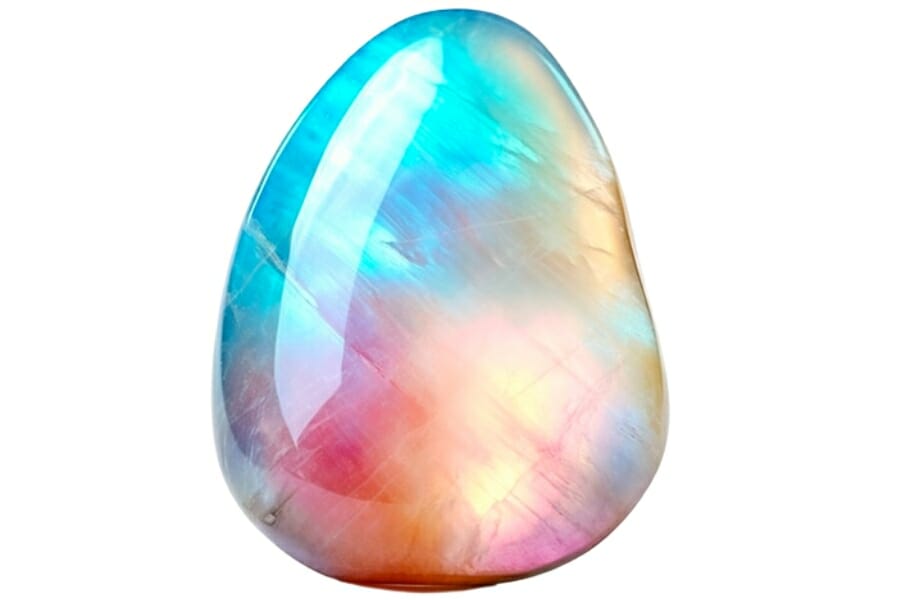Ever held a shimmering gem and wondered if it’s an opalite or a moonstone? These two stunning stones can sometimes seem pretty similar at first glance, but they are each unique in their own cool ways.
Both of them have fascinated people for ages with their magical glow and captivating colors. Holding them is like holding a piece of the galaxy or a drop of moonlight in your hands.
Even though they might look somewhat similar to the untrained eye, there’s a vast contrast between opalite vs moonstone. It can be a bit tricky to tell them apart, and that’s exactly what we’re diving into in this article.
We’re going on a gem-tastic journey to explore the sparkling world of moonstone vs opalite. By the end of this, you’ll be able to see beyond the sparkle to identify these two awesome gems.
Opalite vs Moonstone – The Major Differences
While their looks can appear deceivingly similar, opalite and moonstone actually share more differences than similarities. Surprising, right? Below are the major factors that draw these two fascinating stones miles apart:
Color – Moonstone showcases an adularescence effect

Opalite and moonstone are both mesmerizing stones, but they show off their beauty in different shades and glows.
To start, opalite has a unique, dreamy appearance. It usually shows off a milky blue color, which is one of its trademarks. But here’s the fun part: if you hold it up against a light, it can also glow with a lovely orange-red color.
In the case of moonstone, it comes in a wider range of colors. It can be colorless, pale blue, pink, or even have shades of peach and gray.
But the magic of moonstone is in its special shimmer called “adularescence.” This effect makes it seem as if a soft light is dancing on the stone, moving as you turn it.
So, while both opalite and moonstone can charm anyone with their colors, they definitely have their own unique ways of showing off.
Luster – Opalite has a glassy nature
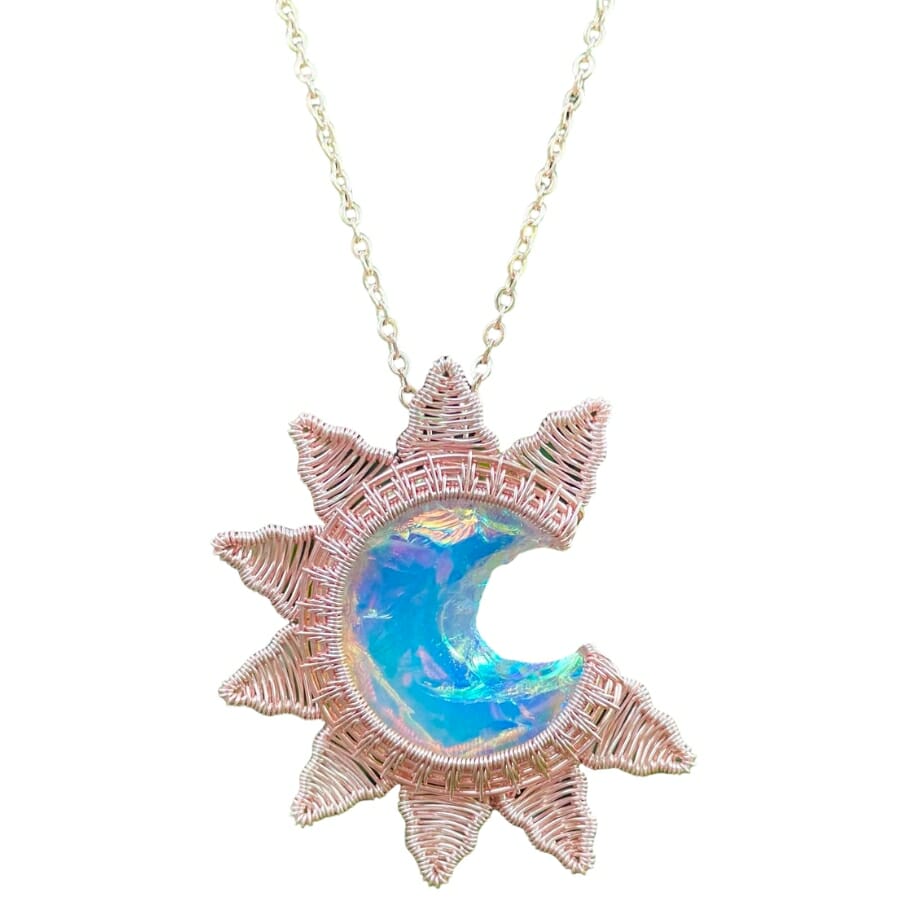
Luster refers to how a mineral or stone reflects light from its surface. Both opalite and moonstone are known for their captivating glow, but they show it off in different ways.
Opalite has what’s called a vitreous luster, which means it shines like glass. And that makes sense because this stone is a man-made glass or resin.
When you look at opalite, you’ll notice it has a consistent, glassy shine all over. It’s smooth, clear, and really catches the light in a bright way. This vibrant luster is one of the reasons opalite jewelry sparkles so beautifully.
Moonstone, on the other hand, also has a vitreous luster, but with a twist! Along with that glass-like shine, moonstone displays a silky sheen. This silky appearance comes from its unique structure inside.
When light hits a moonstone, it scatters and bounces around in the stone, creating the adularescence effect. It’s almost like moonbeams dancing on water. It’s this combination of vitreous and silky lusters that makes moonstone so enchanting.
Crystal Structure – Moonstone has a monoclinic crystal system
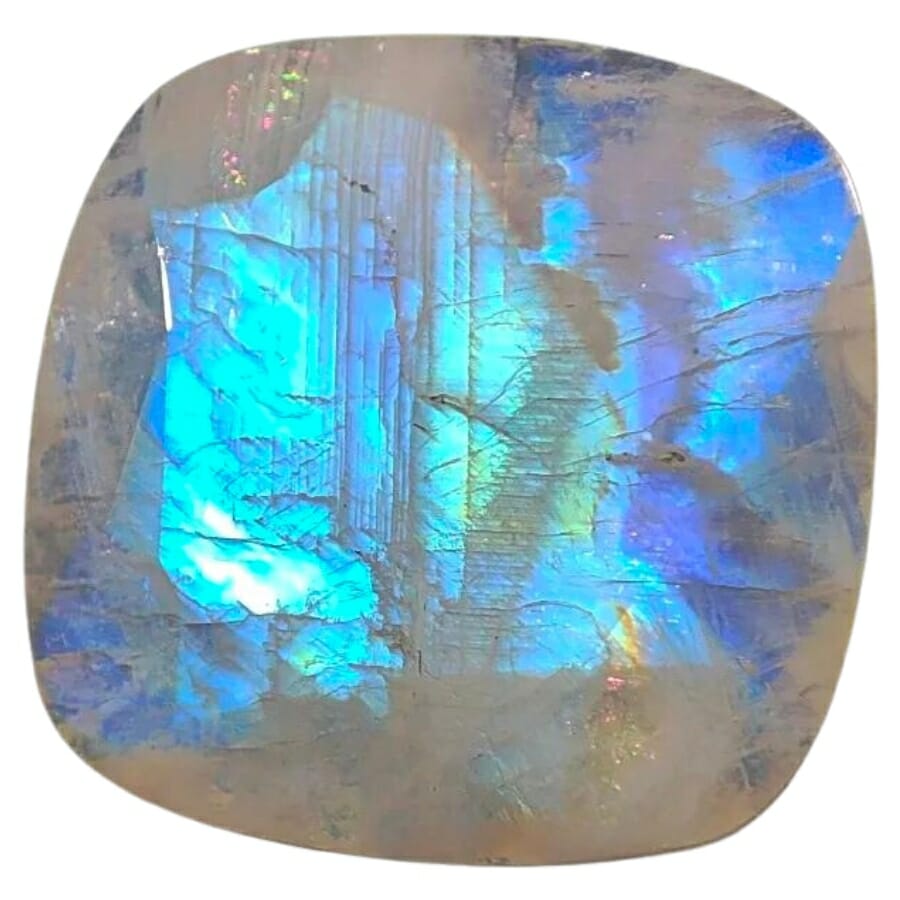
Let’s imagine for a moment that every stone or mineral is like a tiny city. The buildings in that city and how they’re arranged are kind of like the crystal structure of the stone. This structure helps give each rock its unique personality and charm.
Sticking to our city analogy, opalite is like a city that popped up overnight because it’s man-made.
Instead of natural buildings (or crystals) that grew over time, this rock is like a smooth, well-planned area without distinct structures. That’s because opalite doesn’t have a crystal structure in the way natural minerals do. It’s created from glass or resin, so everything in it is more uniform and lacks a specific pattern.
Moonstone, on the other hand, is a natural gem. It has a specific structure, called the monoclinic crystal system.
In our city analogy, think of it as having unique buildings, parks, and roads that all follow a certain design. This monoclinic system means the atoms inside the moonstone are arranged in a special pattern that repeats. This internal blueprint is part of what gives moonstone its magical shimmer and glow.
Cleavage – Opalite doesn’t exhibit cleavage
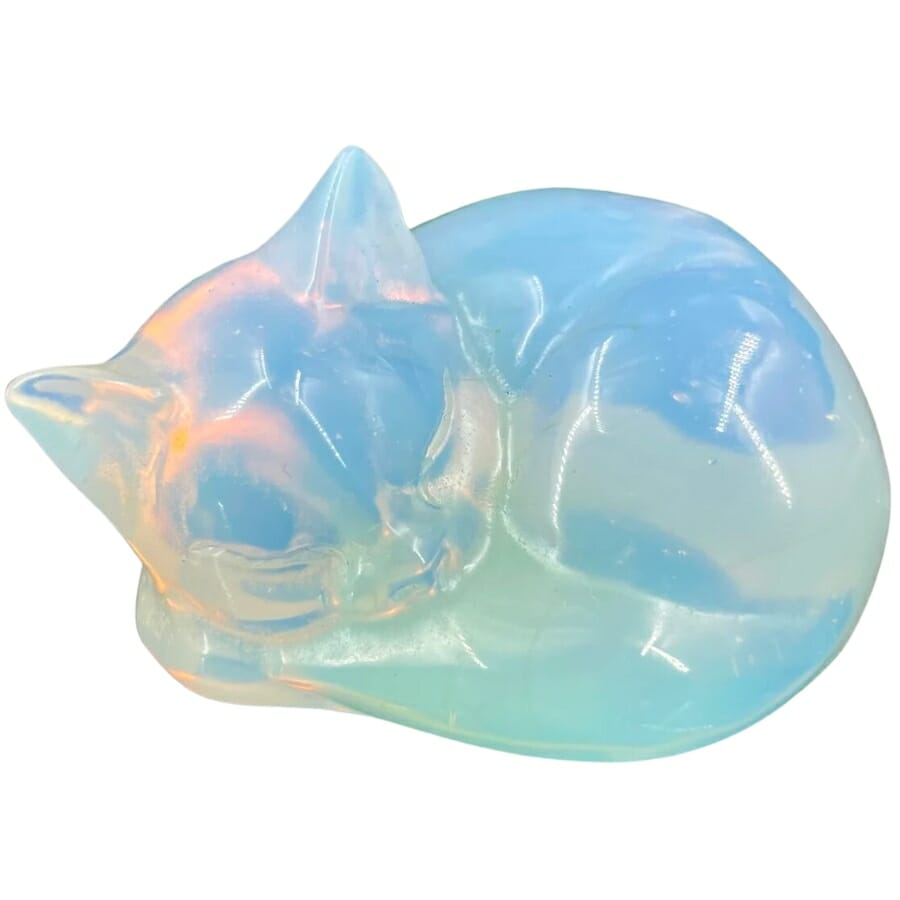
Cleavage is all about how a rock or mineral breaks along certain planes or directions.
Now, remember, opalite is a man-made gem and because of this, it doesn’t really break in the way natural minerals do. Instead of splitting along natural cleavage planes, opalite tends to break more randomly.
Imagine dropping a glass marble. It might crack or shatter, but not in a predictable pattern. That’s kind of how opalite acts.
As for moonstone, it’s got some set ways it likes to break. It has what we call two directions of perfect cleavage.
This means that if you were to try and split a moonstone, it would most likely break in two specific directions. It’s like moonstone has the perforated lines on a paper towel roll.
Composition – Moonstone is a sodium-potassium aluminum silicate
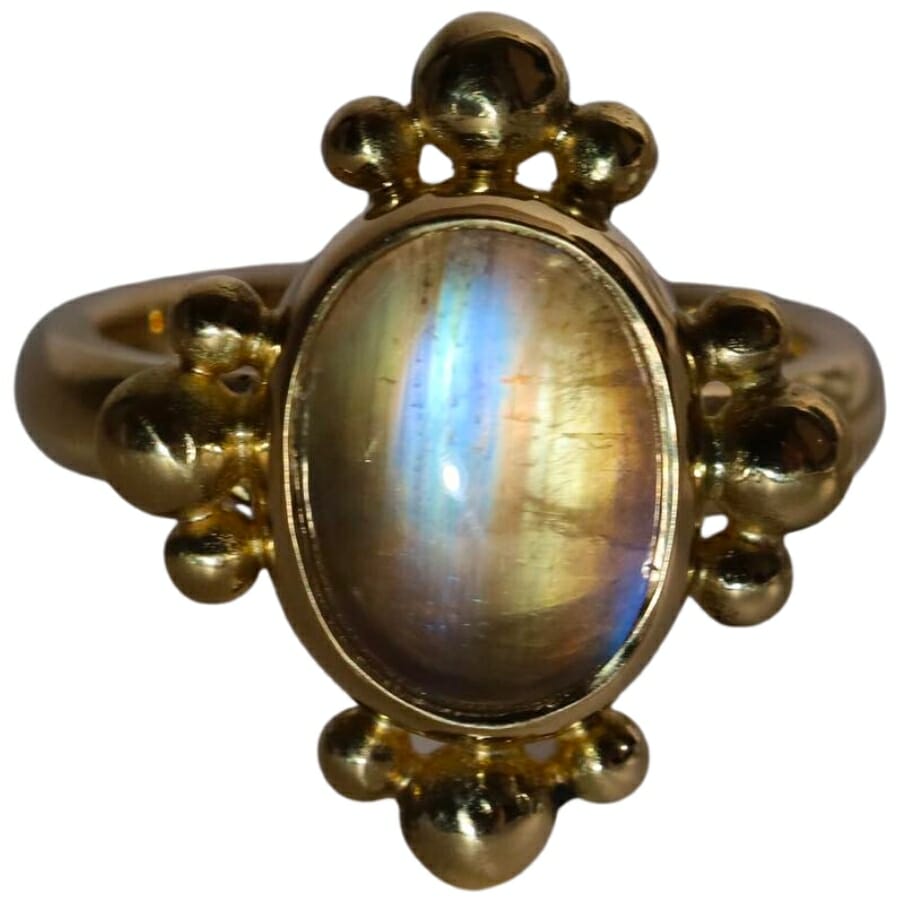
Opalite is like a special recipe someone came up with because it’s man-made. Instead of being formed naturally, people whip up opalite using materials like glass or sometimes resin.
It’s not a natural mix of elements from the ground, but rather a human-made blend. So, its chemical composition is pretty straightforward, mostly made up of what you’d find in glass, like silicon dioxide.
Meanwhile, moonstone is an all-natural treat. It belongs to the feldspar family, which is a big group of minerals.
The main ingredients in moonstone are two types of feldspar: orthoclase and albite. These mix together in layers inside the stone. When light hits these layers, it scatters and gives moonstone its dreamy glow. In a way, the special mix of elements in moonstone is what makes it shine so beautifully.
Formation – Opalite is man-made
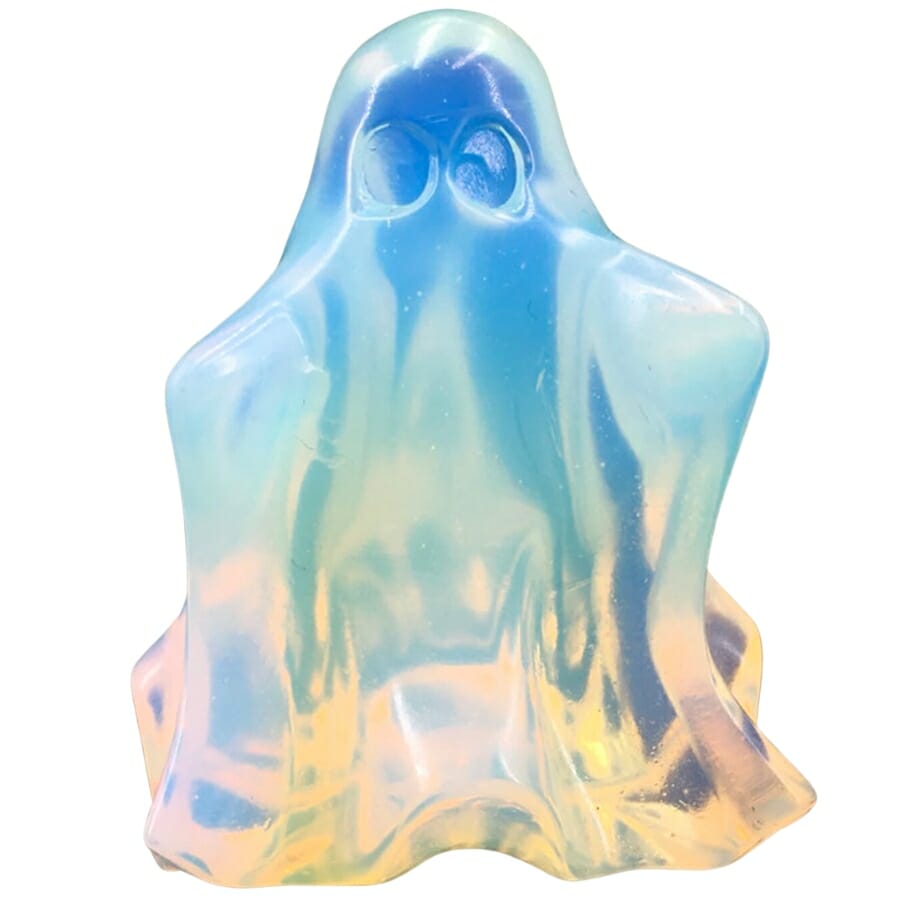
The way both opalite and moonstone form is a bit like a cooking method.
As we’ve already mentioned earlier, opalite is actually not cooked up by the Earth. Instead, it’s made by people. It’s typically created using materials like glass in factories or workshops.
Just like when you melt and mold candy into fun shapes, opalite is crafted by heating and molding its ingredients into that lovely stone we know.
In comparison, moonstone is a natural creation that’s slow-cooked to what it is today. It forms deep underground over millions of years when hot molten rock, called magma, cools down and solidifies.
During this process, certain minerals like orthoclase and albite join together to form layers. These layers are what give moonstone its unique shimmer. Indeed, it’s a slow, patient recipe.
Location – Moonstone naturally occurs in several locations worldwide

Opalite’s location is pretty easy to pinpoint. It doesn’t come from hidden caves or deep mines.
Opalite is man-made, often in factories or workshops. So, while you won’t find it naturally popping up in the ground in far-off lands, you might find it being crafted in various parts of the world where artisans and manufacturers work.
In contrast, moonstone is a natural traveler, found in different parts of the world. Some of the best moonstones come from India, Sri Lanka, and Myanmar. These places have just the right conditions for it to form.
But that’s not all! Moonstone can also be found in countries like Brazil, Madagascar, and even the United States. You can check out our article on the best gem mine sites near you to see where you can find this wonder.
You can also visit our guide on the many great places for rockhounding near you that may have moonstones.
Density – Opalite has a lower density because of its base
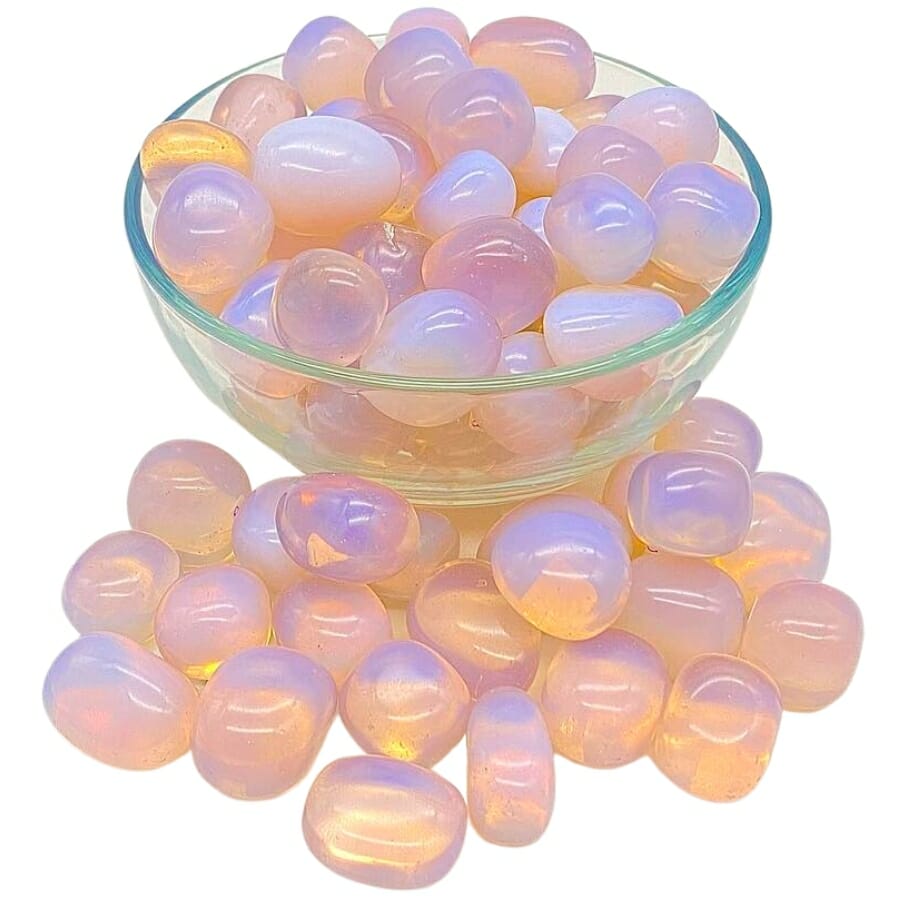
Did you know that every stone has a unique density? Density is like the weightiness of a stone for its size.
Opalite has a pretty solid weight to it. Glass is denser than many natural minerals because it’s so tightly packed on a molecular level. If you’ve ever held a piece of glass, you know it feels pretty solid and weighty in your hand, right?
Moonstone, on the other hand, is a bit lighter in density. When you hold a piece of it, it doesn’t feel as heavy as opalite, even if they’re around the same size.
Moonstone’s natural formation makes its molecules spaced out a bit more, so it’s not as densely packed as opalite.
Hardness – Moonstone is harder based on the Mohs hardness scale
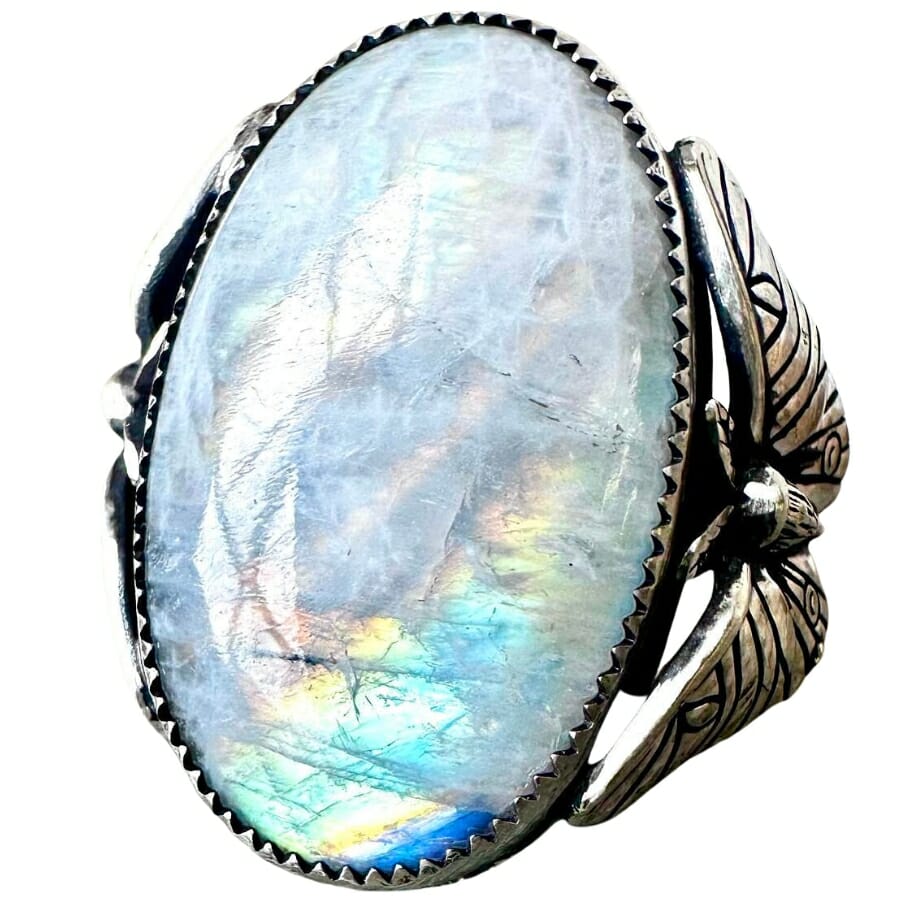
Hardness isn’t just about how tough or strong a rock or mineral is, but rather how easily it can be scratched. Some rocks and minerals can resist scratches better than others.
Remember, opalite is made from materials like glass, which is pretty hard on the surface. If you’ve ever tried to scratch a window, you’d know!
On the Mohs scale, which measures hardness, opalite usually sits somewhere around 5.5 to 6. That’s a medium score, not too soft, but not too hard either. It can take some hits, but it’s not the toughest one out there.
As for moonstone it’s generally harder than opalite, with a hardness of around 6 to 6.5 in the Moh’s scale. Even though it’s still not a heavy hitter in the hardness game, its strength is in its gentle, dreamy glow.
Streak – Opalite doesn’t have a consistent streak
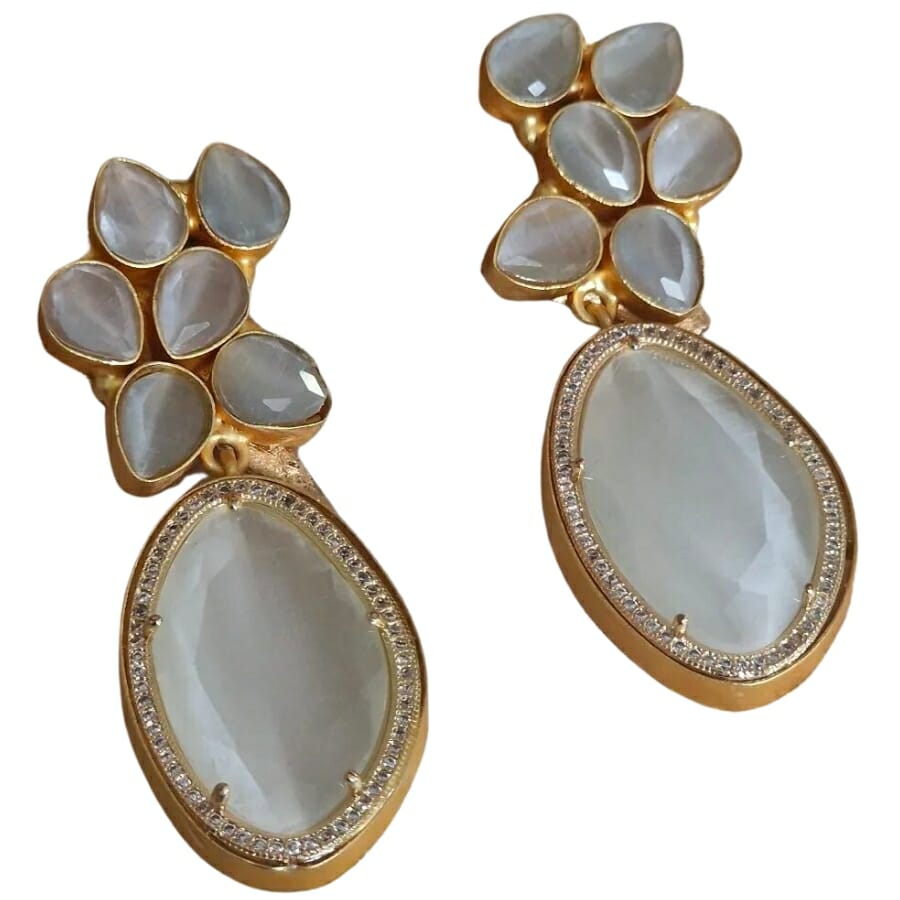
In the world of rocks and minerals, streak means the color of the powder a stone leaves behind when it’s rubbed against something rough, like a porcelain tile. This is a neat trick to know more about your favorite stones.
Opalite is a bit of a wildcard because it’s man-made. It’s often crafted from glass, so its streak isn’t always the same every time.
In many cases, it might not even leave a noticeable streak because of its glassy makeup. Imagine trying to leave a mark with a clear windowpane— not much would show up, right? That’s kind of how opalite behaves in a streak test.
Meanwhile, moonstone, being natural, typically leaves a white trail. It doesn’t matter if your moonstone is blue, gray, or another shade, its streak will most likely be white.
Fluorescence – Natural Moonstone generally doesn’t fluoresce
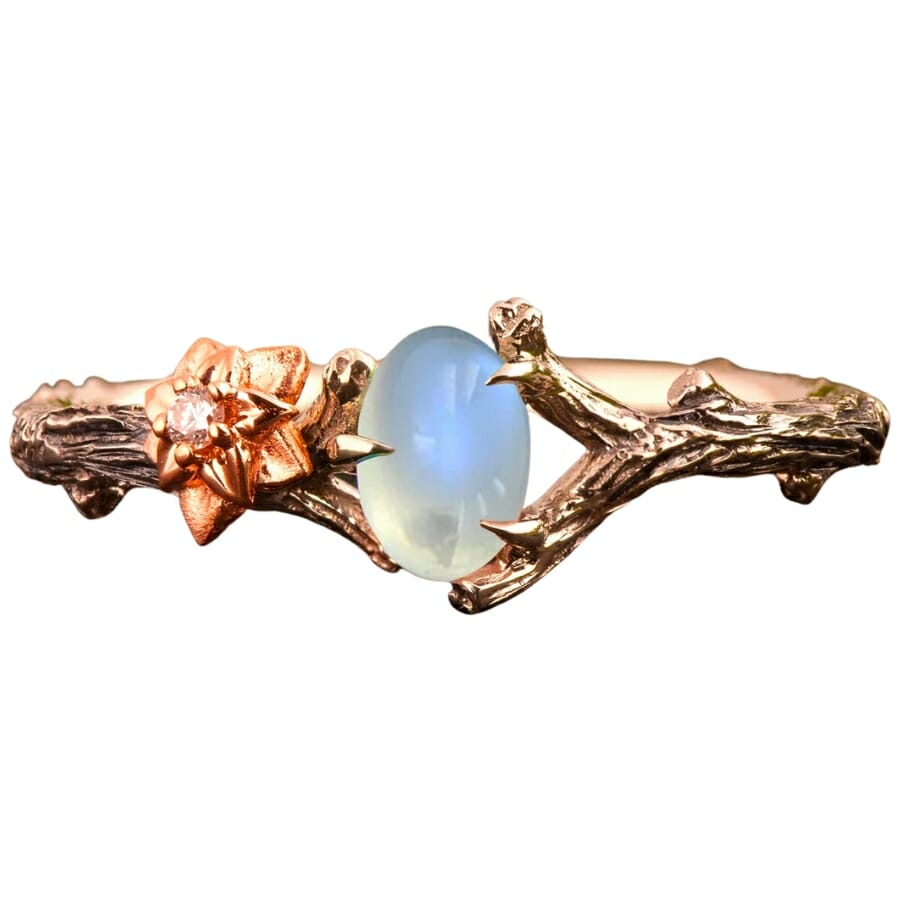
Ever seen something glow under a black light? It’s like a mini-light show! That cool glow is called “fluorescence.” Some rocks and minerals can do this neat trick, glowing in bright, unexpected colors under ultraviolet (UV) light.
When it comes to this factor, moonstone vs opalite really differ. Since opalite is made out of glass, it has a unique behavior under UV light. It can sometimes glow a bright, electric blue when under a black light.
Moonstone, being a natural gem, has a different vibe. Most of these gems don’t have strong fluorescence. They might show a faint glow or no glow at all under UV light.
Price – Opalite is more affordable

Now, let’s go to the exciting part for most of you: the price tags on opalite and moonstone. While they can look alike in many cases, their value and worth vary.
Opalite usually comes with a more predictable price. Since it’s made in factories or workshops, there’s a lot of it available, and it can be produced whenever there’s a demand.
This often means opalite is more affordable. Imagine walking into a store and finding a bunch of cool toys that are made in large quantities. They’d probably be cheaper than rare, collectible toys, right? Opalite is a bit like those commonly available toys.
On the other hand, the price of moonstone can vary a lot based on factors like color, clarity, and where it’s from.
Some moonstones, like the ones with a blue shimmer called “blue flash,” can be more pricey because they’re highly desired. Plus, since moonstone is dug up, there’s a limited amount, making it rarer and more expensive.
In the shopping spree for rocks, opalite is like the budget-friendly, always-available option, while moonstone can range from affordable to a bit of a splurge, depending on its quality and type.
Opalite vs Moonstone – The Similarities
As we said, opalite and moonstone share more differences than similarities, but it doesn’t mean they don’t share anything in common. Below are some of the factors where they’re the same:
Magnetism – Both opalite and moonstone are non-magnetic
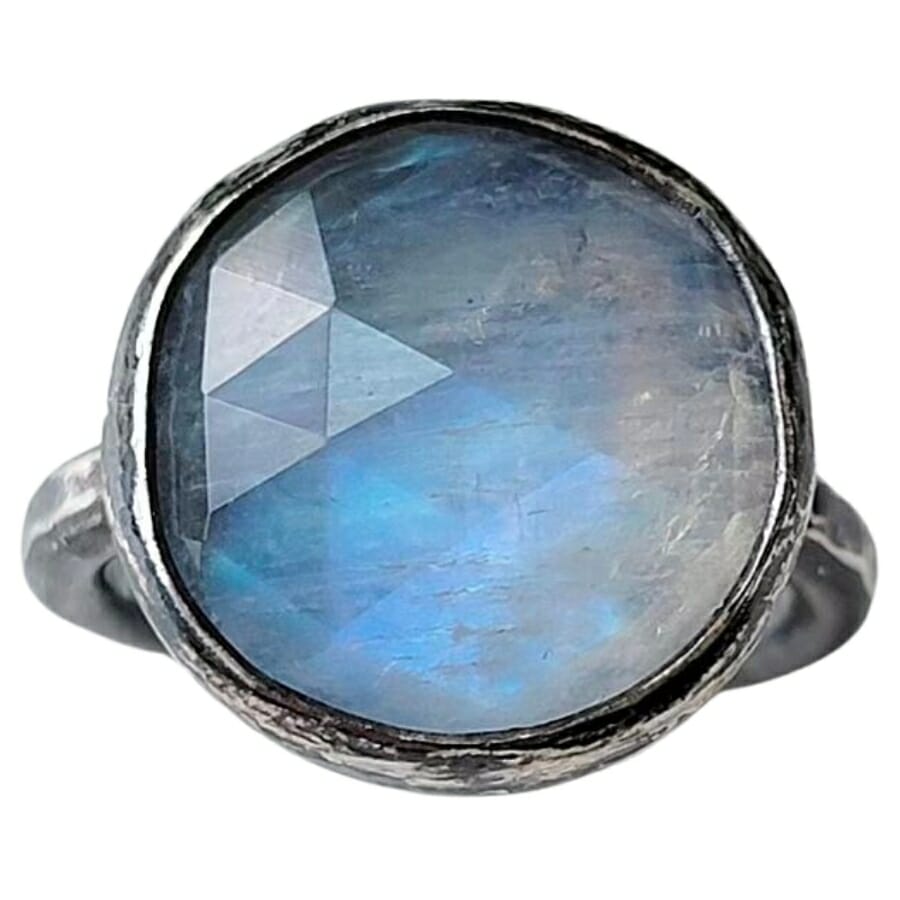
Imagine magnetism as an invisible force, like the superpower that allows superheroes to attract or repel objects. Now, do opalite and moonstone have this magnetic superpower?
Well, both opalite and moonstone aren’t known to be strongly magnetic. That means if you put a magnet near these stones, they won’t jump up to stick to the magnet like metal does.
So, if you’re trying a cool science experiment with magnets, these gems might not join the fun in the way iron or nickel would.
Why aren’t they magnetic? The magnetism of a stone comes from its chemical composition. Neither opalite, which is man-made mostly from glass, nor moonstone, which is a natural mineral, have the right ingredients to be magnetic.
Conductivity – Moonstone and opalite are both poor conductors
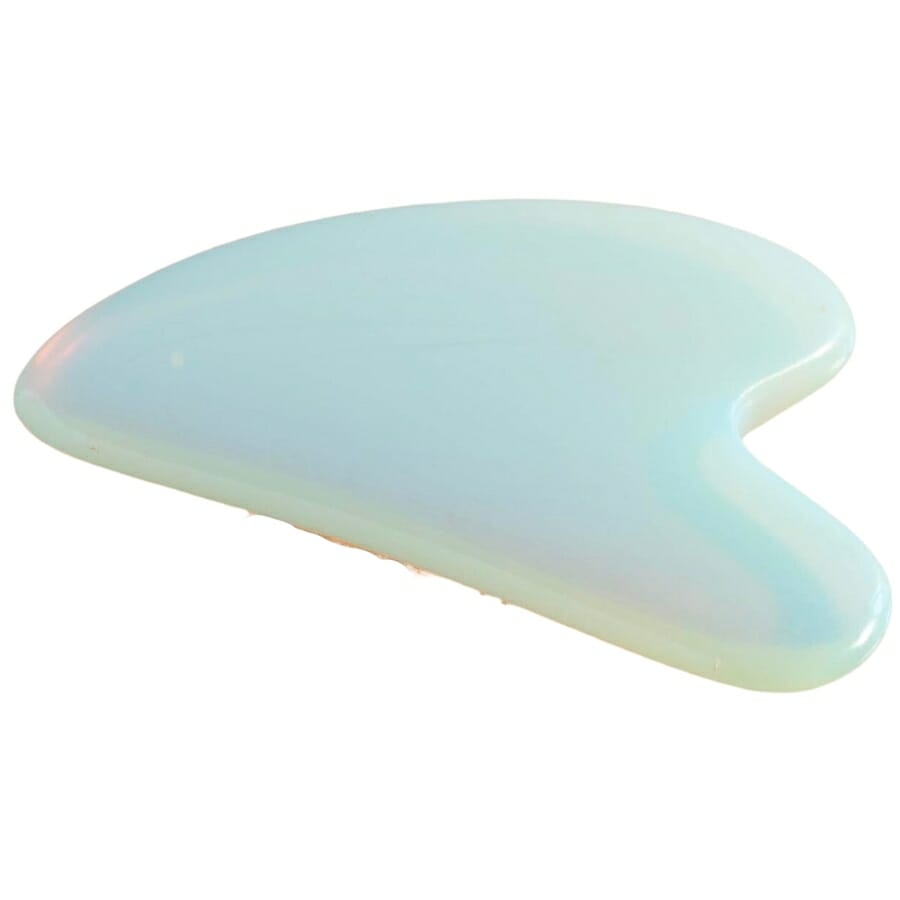
Conductivity is all about how well something can pass electricity. Some things, like metals, are great at conductivity, letting electricity zoom right through.
However, opalite and moonstone are not like metals. One thing they have in common is that they’re both not very good at conducting electricity.
If you try to send electrical energy through them, it would have a hard time getting from one side to the other.
This is because of what they’re made of. Opalite doesn’t have the right stuff inside to let electricity flow smoothly. Moonstone, despite being a natural mineral, also lacks the necessary ingredients to be a good conductor.
The Easiest Ways To Tell Opalite and Moonstone Apart
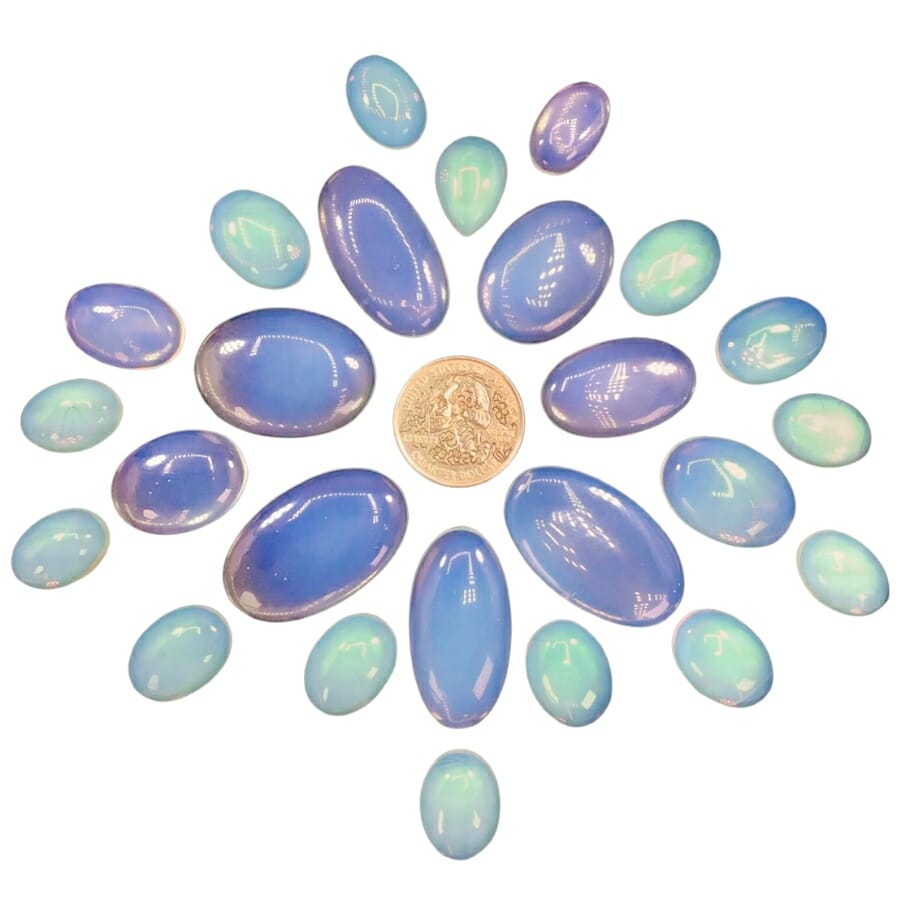
In most cases, the differences between opalite vs moonstone and the few similarities that we shared here will already help you a lot in identifying between them.
But if you need more practical tips and tricks to tell opalite and moonstone apart, below are a few things you can consider doing:
Look at the color play
One of the quickest ways to spot the difference between opalite and moonstone is by looking at the colors that dance inside the stone when light hits it.
Moonstone is famous for its adularescence, the shimmering or glowing effect that seems to move as the stone is rotated, almost like moonlight glowing on water. This effect is caused by the way light is scattered in the stone.
Opalite, on the other hand, has a more uniform glow. When held up to the light, it can exhibit a milky bluish glow. It’s this soft glow that gives opalite its name
Feel the weight
If you have both stones in your hand, moonstone will usually feel a bit heavier than opalite. That’s because natural minerals like moonstones are denser than the glass used for opalite.
Being typically made of glass, opalite will also often feel cooler to the touch initially. Glass has the ability to absorb and retain cold quite well, making it feel cool when you first pick it up.
Meanwhile, moonstone doesn’t have this same initial cool feel. It tends to feel more neutral or closer to room temperature when first held
Opalite also often has a smoother and more uniform surface. It might even feel exceptionally smooth to the touch if it has been polished. Moonstone, on the other hand, may have minor surface irregularities or inclusions. When polished, the presence of these natural characteristics might give it a different tactile sensation.
Check its transparency
Hold the stone up to a light source. Opalite is usually more transparent, allowing more light to pass through, giving it a characteristic glow. It also often exhibits a milky or opalescent appearance
Meanwhile, moonstone can range from transparent to opaque. It often appears cloudier and can exhibit a blue-to-white sheen when light interacts with its internal structures.

